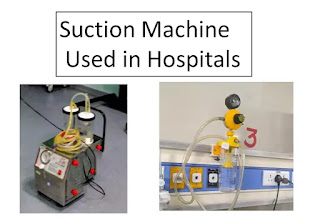Care and Maintenance of Suction Machines
 |
| Care and Maintenance of Suction Machines |
Introduction
Suction machines are essential medical devices used to
remove unwanted fluids or secretions from the body, particularly from the
airway or wound sites. Proper care and maintenance of suction machines are
vital for ensuring their optimal functionality, preventing contamination, and
promoting patient safety.
 |
| Care and Maintenance of Suction Machines |
Importance of Care and Maintenance
Patient Safety:
A well-maintained suction machine ensures effective removal
of fluids, minimizing the risk of airway obstruction and potential
complications for patients.
Device Longevity:
Regular care and maintenance extend the life of suction
machines, reducing the need for frequent replacements and minimizing
operational costs.
Infection Control:
Proper cleaning and
disinfection prevent cross-contamination and the spread of infections between
patients.
Key Steps in Suction Machine Maintenance
Daily Pre-use Inspection:
Visually inspect the suction machine for physical damage or
malfunction.
Check that all connections, tubes, and containers are
properly secured.
Cleaning and Disinfection:
Use hospital-approved cleaning agents to clean external
surfaces and touch interfaces.
Disassemble and clean reusable parts according to
manufacturer instructions.
Empty and clean collection containers after each use to
prevent bacterial growth.
Filter Maintenance:
Replace or clean filters regularly to maintain optimal
airflow and prevent clogs.
Follow manufacturer guidelines for the type and frequency of
filter replacement.
Tubing and Canister Care:
Regularly inspect and replace tubing that shows signs of
wear, cracks, or leaks.
Clean and disinfect collection canisters, lids, and tubing
connections to prevent contamination.
Pressure and Suction Calibration:
Periodically calibrate the suction machine to ensure
accurate pressure levels.
Test the suction strength to confirm that it meets the
desired specifications.
Battery Maintenance:
Check and test the backup battery regularly to ensure it
functions during power outages.
Replace batteries as recommended by the manufacturer.
Storage and Transport:
Store the suction machine in a clean, dry environment when
not in use.
Secure all parts to prevent damage during transport and
storage.
Manufacturer's Guidelines:
Adhere to the manufacturer's recommendations for
maintenance, cleaning agents, and replacement parts.
Regular Performance Testing:
Conduct regular performance tests to ensure the suction
machine maintains the required suction strength.
Use a calibrated vacuum gauge to measure and verify the
accuracy of the suction pressure.
In-Service Training
and Competency Assessment:
Provide ongoing in-service training to healthcare staff to
refresh their knowledge of suction machine operation, maintenance, and
troubleshooting.
Assess the competency of staff periodically to ensure they
are proficient in using and maintaining the equipment.
Seal and Gasket Inspection:
Inspect seals, gaskets, and O-rings for signs of wear or
damage that could lead to leaks.
Replace worn seals promptly to prevent loss of suction power
and potential contamination.
Suction Tubing Management:
Routinely check the suction tubing for kinks, twists, or
obstructions that could hinder proper suction.
Maintain spare tubing and connectors to quickly replace
damaged components.
Waste Disposal and Infection Control:
Properly dispose of suctioned materials according to medical
waste guidelines to prevent contamination.
Clean and disinfect reusable collection canisters thoroughly to eliminate pathogens.
Remote Monitoring and Maintenance:
If applicable, utilize remote monitoring technology provided
by some suction machines.
This allows technical support teams to diagnose issues
remotely and guide on-site staff through troubleshooting steps.
Regular Calibration and Certification:
Schedule regular calibration and certification by qualified
biomedical engineers to ensure accurate and reliable performance.
Certifications demonstrate compliance with safety standards
and regulations.
Ventilation System Inspection:
Check the ventilation system of the suction machine to
prevent overheating and ensure proper cooling.
Adequate ventilation prolongs the life of internal
components.
Staff Feedback and Continuous Improvement:
Encourage healthcare staff to provide feedback on the
usability and performance of suction machines.
Use feedback to implement improvements and address any
recurring issues.
Staff Training and Documentation
Staff Training:
Provide thorough training to healthcare staff on the proper use,
care, and maintenance of suction machines.
Emphasize the importance of following protocols for
infection control.
Record-Keeping:
Maintain detailed records of maintenance tasks, calibration
results, and repairs.
Document the date of the last maintenance and the
responsible staff member.
Troubleshooting and Repairs
Common Issues:
Familiarize staff with common suction machine issues, such
as reduced suction power or blockages.
Train them to troubleshoot minor problems and escalate
issues as needed.
Scheduled Maintenance:
Establish a schedule for routine maintenance tasks, such as
filter replacement and calibration.
Assign responsibilities for these tasks to ensure
consistency.
Proper care and maintenance of suction machines play a
critical role in patient care and safety. By following the outlined steps and
adhering to manufacturer guidelines, healthcare professionals ensure that
suction machines are reliable, effective, and free from contamination. This
attention to maintenance contributes to positive patient outcomes and the
overall quality of healthcare services provided.
Recommended Topics
Label List
- BASIC CONCEPTS (19)
- ANESTHESIA EQUIPMENTS (18)
- Exam (13)
- study material (12)
- MCQ FOR OT TECHNICIANS (11)
- ANESTHESIA PREPRATION (10)
- DEVICES USED IN OT (7)
- random topics (7)
- CSSD & OTHER DEVICES (6)
- FIND A JOB (5)
- QUESTION PAPERS (5)
- latest updates (4)
- DRUGS (3)
- PATIENT CARE (3)
- Registration (3)
- Surgical Instruments (3)
- History of Anesthesia (2)
- by - Ritika Sharma (1)


Post a Comment
Post a Comment